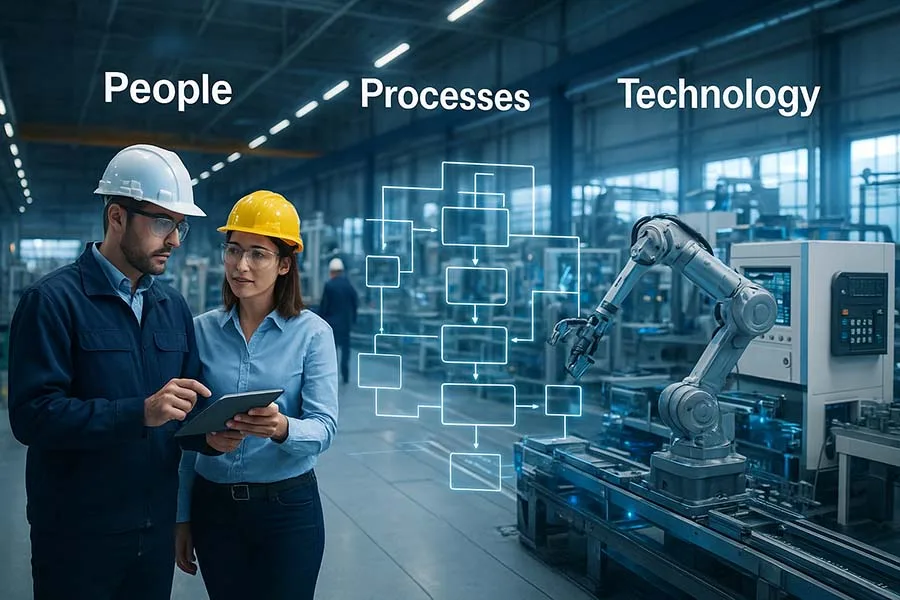1. People: The Heart of Industrial Operations
Humans remain the most critical element of any operation. Understanding and investing in your workforce brings tangible benefits:
- Enhanced Productivity: Skilled and well-trained employees complete tasks faster, make fewer mistakes, and adapt more easily to technological changes.
- Employee Engagement: People who understand their role within larger workflows are more motivated, which improves retention and reduces turnover.
- Knowledge Retention: Structured training and documentation prevent the loss of institutional knowledge during staff changes.
Lesser-Known Fact: Many companies ignore informal communication networks within teams. Mapping these can reveal hidden bottlenecks or innovation hubs that standard workflows overlook.
Tip: Regular cross-training and mentorship programs ensure employees can cover multiple roles efficiently, reducing dependency on single points of knowledge.
2. Processes: The Blueprint for Consistency and Growth
Processes act as the invisible infrastructure connecting people and technology. Optimizing them provides:
- Consistency: Well-defined workflows reduce variability and errors, ensuring predictable outcomes.
- Scalability: Clear processes allow operations to expand or adopt new technologies without chaos.
- Problem Solving: Understanding workflows in depth makes it easier to identify inefficiencies and bottlenecks.
Funny Fact: In high-tech factories, sometimes a missing sticky note or misnamed spreadsheet can create more disruption than a full system failure.
Pro Tip: Visualizing processes through flowcharts, digital twins, or process maps often uncovers inefficiencies faster than traditional manuals.
3. Technology: The Enabler of Modern Industry
While technology is the most visible element in industrial operations, its full potential is realized only when paired with people and processes:
- Automation Efficiency: Machines and robots handle repetitive tasks accurately, freeing humans for higher-value work.
- Data-Driven Decisions: IoT devices, sensors, and analytics tools provide actionable insights to improve operations.
- Innovation Catalyst: Understanding technology’s strengths and limitations prevents over-engineering and ensures maximum ROI.
Lesser-Known Fact: Over 60% of automation projects fail to reach their potential due to poor integration with people or processes—not technical flaws.
Tip: Always treat technology as a tool to amplify human capabilities, not a replacement.
4. Integrating People, Processes, and Technology
The greatest benefits emerge when all three foundations work together:
- Faster production cycles and reduced errors
- Lower operational costs
- Greater adaptability to market changes
- Stronger workplace culture and morale
Think of it as a three-legged stool—if one element is weak, the system wobbles. Balancing these foundations creates sustainable efficiency and a measurable competitive advantage.
5. Practical Steps to Maximize Benefits
- Assess Current State: Evaluate your workforce skills, existing workflows, and technology stack.
- Align Foundations: Ensure processes match both human capabilities and technological potential.
- Invest in Training: Empower employees to leverage new tools effectively.
- Document Workflows: Use flowcharts, SOPs, or digital twins to create clarity.
- Monitor & Optimize: Continuously review KPIs and adapt to changes in demand, technology, or workforce composition.
Core Foundations FAQ
Further Read
- Core Foundations of Industry 4.0: The Tech Stack Explained
- Industrial Internet of Things (IIoT): Connecting Machines, Data, and People
- Digital Twin Technology: From Concept to Real-World Applications
- Robotics and Automation: The Heart of Smart Manufacturing
- Artificial Intelligence (AI) and Machine Learning: Smarter Manufacturing
- Augmented Reality (AR) and Virtual Reality (VR): The Human-Tech Interface
- Data Analytics and Cloud Computing in Industry 4.0
- Cybersecurity in Industry 4.0: Protecting the Smart Factory
- Integration and Interoperability in Industry 4.0
- Benefits of Understanding the Core Foundations: People, Processes, and Technology
- Challenges and Barriers in Industry 4.0: Overcoming the Roadblocks to Smart Manufacturing
- The Future of Manufacturing: Towards Industry 5.0
Conclusion
Understanding the core foundations—People, Processes, and Technology—is no longer optional in modern industry. Companies that master this triad unlock efficiency, innovation, and resilience. Investing in each element and integrating them effectively ensures sustainable growth, stronger teams, and a competitive edge in any market.





